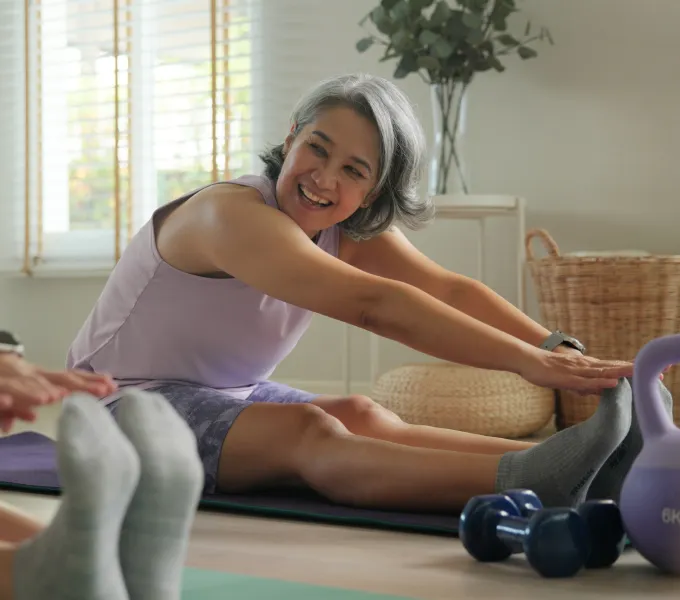
Why Fitness Classes Won't Fix Your Pelvic Floor (Not Even Yoga)
There's no doubt about it, taking exercise classes can be one of the best things you can do for your mood, energy, fitness, and overall well-being. Whether you join a yoga studio or a CrossFit gym, you're likely to build strength, improve your cardiovascular health, and connect with a fabulous community of people who want to feel good in their skin.
Alas, if you expect that same exercise class to stop you from leaking when you sneeze, you're in for some disappointment. The truth is that not even the best yoga or pilates class can fix your pelvic floor. Case in point, studies have found that 1 in 4 fitness instructors — including yoga and pilates instructors — experience incontinence at least once a week.
1 in 4 fitness instructors — including yoga and pilates instructors — experience incontinence at least once a week.
This isn't to say that these instructors are bad at their job, nor does it mean that fixing your pelvic floor is so challenging that even the fittest fit people in the world can't do it. What it comes down to is this: While licensed fitness instructors know all about strengthening and stretching your quads, biceps, and pectoral muscles, they simply aren't trained in pelvic floor muscle dysfunction or how to address it.
Most Exercise Classes Skip the Pelvic Floor
It would be amazing if fitness instructors did have official training in pelvic health. Exercise classes could be a perfect opportunity for people to strengthen and build coordination in their pelvic floors. After all, fitness instructors are great at giving cues and reminders to consider different muscle groups during exercise. And class participants are already interested and invested in improving their bodies; so taking the time to include the pelvic floor seems like an obvious win.
Making pelvic floor work standard in fitness classes would be especially helpful given that nearly 50% of women of all ages who currently participate in exercise classes report having urinary incontinence and could benefit from building strength in their pelvic floors. Talking about symptoms in class could help banish stigma and encourage people to get the help they need. As is, the majority of fitness instructors aren't screening for pelvic floor dysfunction among their class participants and most participants are too embarrassed to bring it up.
46% of all women who exercise say that they've skipped workouts due to symptoms of pelvic floor dysfunction.
With so much taboo around pelvic health issues like bowel leaks or pain with sex, yogis, pilates enthusiasts, and gym goers alike aren't learning what to look for in terms of pelvic floor imbalances. This lack of open dialog can be discouraging and isolating, leading as many as 46% of all women who exercise — including young adults who have never had children — to stop working out when symptoms like pelvic pressure or accidental leakage do crop up.
It's Not Just About Squeezing & Releasing
On the brighter side, 85% of fitness instructors report being open to incorporating pelvic floor exercises into their classes, if given appropriate training.
Without that training, instructors are often telling exercisers to "squeeze like you're trying to hold in pee," which isn't enough. Kegels require more personalized instruction than most people realize — 1 in 6 women who do pelvic floor exercises without expert guidance, do them incorrectly. And, for some people with overly tight pelvic floors, kegels can make their symptoms worse instead of better. This is likely why, when fitness instructors do cue for pelvic floor activation, research shows no improvement in their class participants' incontinence symptoms.
Pelvic Floor PT Can Make All the Difference
Here's what's really promising: After an individual works one-on-one with a pelvic floor physical therapist, doing pelvic floor exercises in a class setting has been found to be effective. Seeing a PT first gives you the opportunity to understand the unique underlying causes of your symptoms and learn how to restore strength, coordination, and balance in your body. So that, later on, when a fitness instructor suggests a pelvic floor exercise or stretch, you'll know whether you should skip it or modify it to fit your needs.
Hopefully, in the near future, more fitness instructors will seek pelvic floor PT for their own symptoms and discover how they can incorporate conversations about the pelvic floor into their classes in a way that gets positive results.
In the meantime, if you have signs of pelvic floor dysfunction, please don't ignore them, or assume a fitness class will fix them, or decide to stop exercising altogether. Instead, reach out to a pelvic floor physical therapist. We're here to help!




